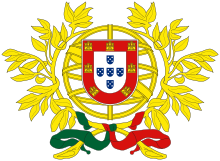Quinas
In heraldry, Quinas is the name given to the five small blue heraldic shields with five, but also seven, eleven or sixteen white dots that appear in the Portuguese coat of arms and on flags.
origin
The son of Henry of Burgundy declared in 1139 after the battle of Ourique against the Moors the independence of Portugal from his liege lords Castile and was crowned as Alfonso I as the first king of Portugal. In 1143 the independence of Castile was recognized in the Treaty of Zamora . Until then, Alfons had the same shield as his father Heinrich. According to a source from 1908, after his recognition as king, Alfonso added eleven silver coins ( besantes or dinheiros ) to the cross five times as a sign of his new status . They are supposed to symbolize the king's right to coin.
At the time, it was common practice to repair the combat damage on shields rather than making new ones. Hence, changes in heraldry such as color changes, loss of parts of symbols, or alterations were not uncommon. The shield of Alfonso I is said to have been badly damaged when his son Sancho I inherited it. The blue leather of the cross was only held in place by the silver nails that symbolized the coins. This supposedly led to the leather being cut into small blue shields (the five quina ) with eleven coins each in the center. The point of three of the four outer shields pointed towards the center of the cross. The importance of the battle of Alfonso I near Ourique, in which he defeated the five Moorish kings of the Taifa kingdoms of Seville , Badajoz , Elvas , Évora and Beja , and took away their shields. Sancho's son Alfonso II and grandson Sancho II kept the coat of arms . Even today, the five quinas form the center of the Portuguese coat of arms.
They belong to the common figure . In the coat of arms the arrangement is crosswise in the form of a common cross .
King Alfonso III added Castilian castles in a red frame to the coat of arms from 1248, so that all elements of today's coat of arms of Portugal were present.
See also
- Coat of arms of the colonies of Portugal
- Coat of arms with Quinas
- Flag of Portugal
- Coat of arms of Ceuta

